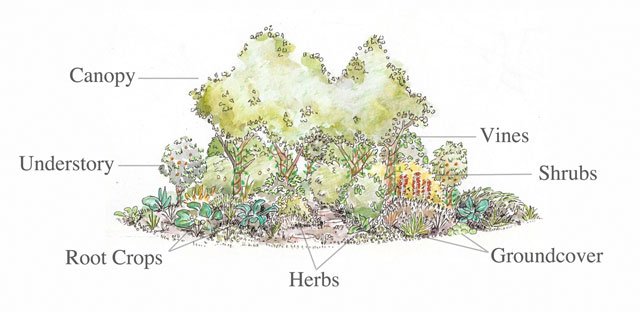all the world's problems can be solved in a garden -Geoff Lawton
A food forest is an agricultural method that builds its design and implementation method off of the natural cycles and layers of a forest. The structure is of a forest with all of the plants serving a specific function in the ecosystem while simultaneously providing a function of usefulness, such as food and medicine.

Layers
Canopy
The canopy layer consists of the largest trees, reaching above all of the other growth. It is common to see nut trees in this layer. In smaller food forests it is not uncommon to see semi dwarf and standard sized fruit trees serving this function. The Canopy creates the micro climate to suite its under-stories. They create large amounts of biomass and carbon as well as store vast amounts of water.
Sub-canopy
Like the canopy, this layer supports life beneath it. It creates more shade and adds to the biomass, as well as providing browse for wildlife.

Shrub
The shrub layer fills in the gaps, often thriving in small openings of sunlight and in drip-lines or on forest edges. In a food forest the shrub layer usually consists of a variety of berries, providing delicious fruit all season long.
Herbaceous
Similar to the Shrub layer, most Herbaceous plants crop up where the can find small patches of sunlight. This layer usually consists of most of the medicinals, however its often that you will find rhubarb, horseradish and asparagus in this layer as well.
Ground cover
There is a large variety of useful ground covers that are well adapted to the shady environments at the bottom of the forest ceiling. These plants serve as a living mulch, completely extinguishing any light left over from touching the ground.
Subsurface
Often times this layer can also be placed into the herbaceous or ground cover layer. Its main difference is that it provides root crops. Sweet Potatoes, radishes, beets, and many other tubers do well here, depending on placement. They also serve the function of aerating the soil.
Fungi
Fungi plays an extremely important role in the health of a forest ecosystem. This incredible living organism can attach itself to plants and form a network through the forest to exchange nutrients between plants. This has been called natures Internet. Fungi, of course, also helps break down biomass into rich soils, breaks down toxins, and in some cases provides us with food.

Vertical
The vertical layer of the forest are our vining plants. Creeping up the sides of our other layers they occupy unused spaces, adding to productivity. Hops, passion fruit, hardy kiwi, and grapes are often used.
Animals
Wildlife plays a very important role in a natural forest. They are often underutilized in food forest management. It is incredible how much work properly managed chickens alone can save you. Domesticated livestock can perform the function of wild animals in nature. They rake through dead organic matter, aerate the layers by browsing vegetation, allowing airflow and preventing molds and dangerous fungal diseases. And they turn their food into rich concentrated fertilizer.
There are several ways to construct a food forest. Small scale and urban food forests are usually intensively planned down to the exact placement of each individual plant. Where as with large food forests it is more common to let forest succession and natural patterns make many of those decisions for you, as you assist it in its development.
Here is a video tour of a suburban food forest
In the future I will create posts on how to construct food forests on various scales. Until then i'd like to hear about other people's experience with food forests

Great information, looking forward to more... just about to do an indoor tower myself.
Certainly makes good sense to me! upvoted
great information. I have an interest in micro farming. This reminds me of some of those techniques
We live in a food forest! https://steemit.com/food/@gardenofeden/feasting-on-mouthgasmic-cuisine-in-our-sustainable-community
I am into 3 years of planting and building my backyard food forest.
Excellent. Imagine if the world used this method to reclaim our food independence and health. Even turning the Sahara into an Eden is not impossible. Why is it that humanity only seems able to mobilize in destruction?